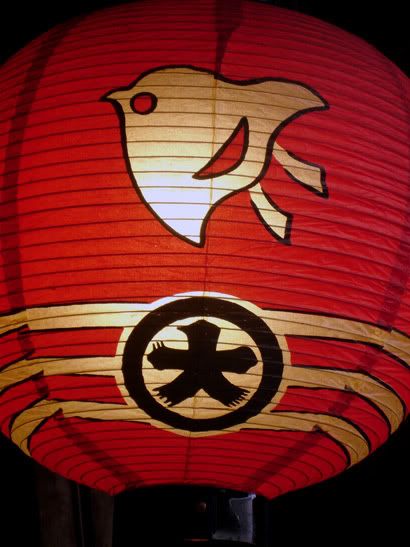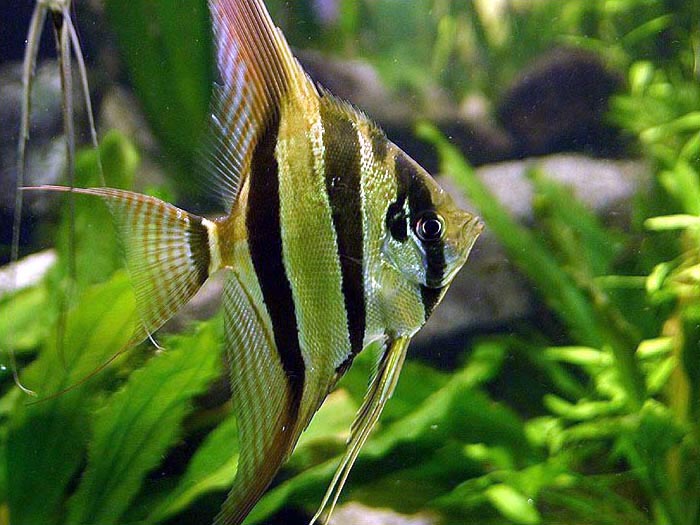If you use the two fingers underneath / thumb on top method (or, as someone else said, if you are drinking directly from it), the saucer is essential; otherwise, it's not as useful. Personally, I usually leave the saucer in the closet. Without it, it's easier to overfill and then tip off some extra water.
Jun 27th, '08, 13:48
Posts: 2625
Joined: May 31st, '08, 02:44
Scrolling: scrolling
Location: Portland, OR
Contact:
Geekgirl
Other problem is that Pterophyllum is a S. American species, and the one you posted is only found in the Amazon, so... hehe. HEY! Maybe the chinese were in the Amazon basin?britt wrote: I've made this mistake several times before. I must subconciously relate fish with the ocean more than I do birds. I think seeing waves and something that does resemble an angel fish leads to the quick conclusion that they're fish in the water, not birds flying over the water.
A while ago I was looking at an incense holder that was shaped like a ship and had fish painted on the hull. This made sense to me, until I read the description and saw they were really birds (plovers, of course).
The one in the lead does look like a bird, but the following ones looked like fish to me. When I first saw this, I wondered why a bird was leading a school of fish. That's when I checked the item description and realized my error.
Kogo, ship with plovers:
Angelfish:
Jun 27th, '08, 14:42
Posts: 1953
Joined: Apr 6th, '08, 19:02
Location: British Columbia, Canada
Contact:
chamekke
What a gorgeous kogo! I think maybe the first plover's body is slightly turned to indicate that it's leading the others. You don't often see that type of semi-naturalistic perspective with this depiction of chidori. Nice touch.britt wrote:A while ago I was looking at an incense holder that was shaped like a ship and had fish painted on the hull. This made sense to me, until I read the description and saw they were really birds (plovers, of course).
The one in the lead does look like a bird, but the following ones looked like fish to me. When I first saw this, I wondered why a bird was leading a school of fish. That's when I checked the item description and realized my error.
Kogo, ship with plovers:
The plover (chidori) was also chosen as the mon or crest of the geiko (geisha-s) of the Pontocho area in Kyoto, perhaps because plovers are plentiful on the nearby river Kamogawa. The geiko use the symbol on their lanterns:

Jun 28th, '08, 16:41
Posts: 1953
Joined: Apr 6th, '08, 19:02
Location: British Columbia, Canada
Contact:
chamekke
By reading voraciously about JapanThirsty Daruma wrote:Where DO you get this knowledge chamekke?
Seriously, it all began when I became interested in Japanese textiles... that led me to tea ceremony and also (secondarily) to the informal study of Japanese design motifs, mon (crests), and so forth.
Japanese traditional culture emphasizes displaying and wearing items that have seasonal themes, whereas in the West we tend to disregard seasonality except where holiday-specific motifs are concerned. Actually, one of the gifts of tea study is that it enabled me to really notice and appreciate the turning of the seasons here, and when certain birds/flowers/insects etc. appear and vanish from the scene.
______________________
"Never trust a man who, when left alone in a room with a tea cosy, doesn't try it on."
- Billy Connolly
"Never trust a man who, when left alone in a room with a tea cosy, doesn't try it on."
- Billy Connolly
chamekke, thanks to your posts I finally know what a mon is. I see the term often but I didn't realize it referred to family crests.chamekke wrote:By reading voraciously about JapanThirsty Daruma wrote:Where DO you get this knowledge chamekke?
Seriously, it all began when I became interested in Japanese textiles... that led me to tea ceremony and also (secondarily) to the informal study of Japanese design motifs, mon (crests), and so forth.
Japanese traditional culture emphasizes displaying and wearing items that have seasonal themes, whereas in the West we tend to disregard seasonality except where holiday-specific motifs are concerned. Actually, one of the gifts of tea study is that it enabled me to really notice and appreciate the turning of the seasons here, and when certain birds/flowers/insects etc. appear and vanish from the scene.
You not only have a tremendous knowledge of Japanese art, culture, and tea; you also have some great sources of pictures to demonstrate what you're saying. This is very helpful, like the pic of the lantern with the angel fish, I mean plover on it!
It is very interesting, but not really surprising, that your interest in Japanese textiles led to your study of the tea ceremony. As they say, the tea ceremony has influenced all other areas of Japanese culture. Although I don't purchase or use a matcha chawan based on the season, my interest in them has at least made me aware of how much emphasis the Japanese place on the different seasons. This gives us a more diverse selection to choose from, and could also be used as an excuse to purchase more of them!

